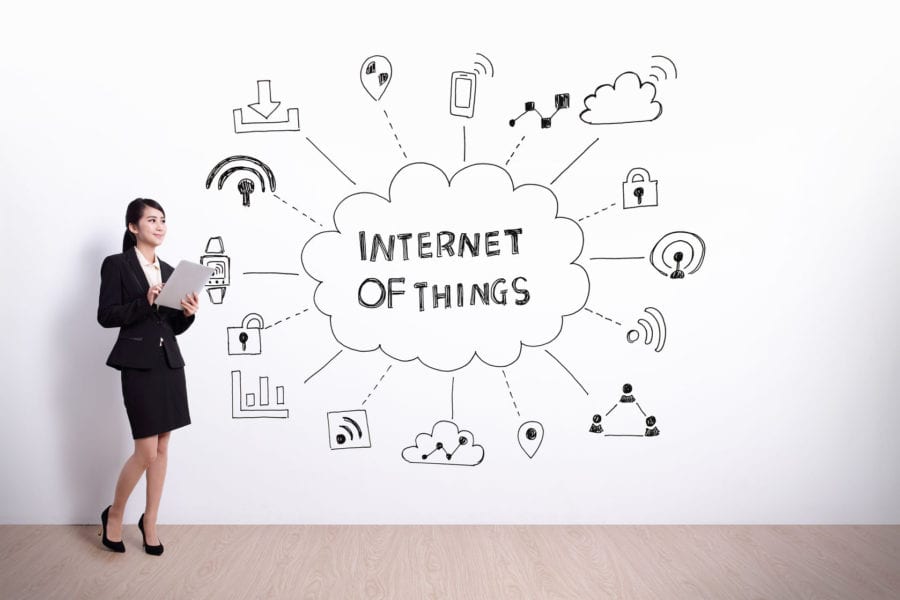The Internet of Things

PROS and CONS of the Internet of Things (IoT)
There is nothing worse than being in a crowded grocery store on a freezing cold day and standing in the dairy section trying to remember whether or not you have milk in your refrigerator. If only there were a way for you to be able to peer into your refrigerator from your smart phone and see what’s in there. Oh wait…there is!
The ever-increasing world of smart technology is producing a “smart” everything, including refrigerators! Welcome to The Internet of Things. Now you can open an app and check out your refrigerator to see what’s in there, you can even start to brew a pot of tea before you leave the store, so that when you get home, it’s waiting to warm you up.
Right now, there is a continued consumer push for devices like the Amazon Echo (home products) and the FitBit (wearables). They are so cool and trendy that you want all of them. You figure this stuff “just works,” while not clearly understanding what it is that these devices really do. What are the pros and cons associated with their connection to the Internet?
WHAT YOU NEED TO KNOW
The Internet of Things (IoT) is the networking of physical devices, vehicles, home appliances, and other items embedded with electronics, software and Internet connectivity.
Your smartphone is probably your first exposure to this, as without its connection to the Internet, you would only be able to make phone calls. The IoT allows you to expand from just calls, to getting your emails, or paying for your Starbucks coffee quickly without interrupting your day.
PROS
Information is now more than at our fingertips—it’s actually at our voice command. Now in our Smart Homes, we can simply ask, “Alexa? What’s the weather going to be like today?” and the answer is given. The technology can activate thermostats, make purchases and reservations, as well as vocally announce your appointments for the day.
Improving our lives + environment:
- Instant information & monitoring of devices
- Automation of daily tasks
- Conveniently control aspects of your home from remote locations with apps
- Money savings through energy efficiency
CONS
The device that is doing all these incredible things has a connection to the Internet, which means it can possibly be compromised. Cyber Security is now a concern for your Amazon Echo, right down to your teapot (if you get that connected). These access points can increase the risk of sensitive information being stolen.
For example, in the late 90’s a Land Rover was hacked and controlled with little effort by paid hackers. In the privacy arena, an Amazon Echo’s recordings could have become courtroom evidence in trial. In all honesty, an access point as low as a thermostat could lead into your home network, computer system—and into your passwords, as well as access to credit card information. Think of it like someone getting into your hotel room and hopping on the phone to order room service or charging your room for a massage.
Issues + concerns:
- Security and Patching – security patches and firmware updates are released to make a more stable and secure device.
- Privacy – how is our data is being used?
- Compatibility & Complexity – how well does the device work with the latest security protocols, and is it too complex for you to configure?
- Internet Connection – It will always be required for the device’s functionality.
WHAT DOES THIS MEAN IF YOU WANT AN IOT DEVICE?
The Internet of Things is a shiny, intriguing and revolutionizing piece of technological advancement. It is expected that there could be as many as 26 billion devices under the “connection” by the year 2020.
With this being said, like most technology, it is going to grow whether you want it to or not. After all, the purpose of new technology is to improve the quality of our lives or the environment in which we live in. Here are some tips to help you integrate this technology into you daily lives:
- Ask questions and read reviews online! Do as much research as you can and ask questions online about how you can protect your device and information.
- Make sure your home WiFi is using WPA2 Encryption, and make sure your wireless security key is extremely strong (using numbers, letters and special characters).
- Always have a backup plan or be prepared for outages. The Internet and your ISP are involved, so outages do limit your ability to connect remotely.
The more we rely on these technologies as part of our lives, the more points of failure we introduce into our everyday living. We have to make sure that we are aware of all the devices we have, how they are using our data, and most importantly, we have to keep up-to-date on firmware updates, patches and security protocols to ensure we are not leaving holes. The days of “set it and forget”, unfortunately, are over.

Related Insights
Copeland brand refresh five year anniversary
May 11, 2023
It’s hard to believe it’s already been five years since we unveiled our brand refresh. Looking back, it was a pivotal moment for Copeland. It marked a shift in how we presented… Read more
How MSPs can help SMB leaders leverage technology to grow their business
October 20, 2021
Eric Posa, President at Copeland Technology Solutions, will join Nodeware on October 28th, 2021 at 1P EDT to discuss how MSPs can help business leaders grow their business and improve their profitability. During this… Read more
Copeland Newsletter: Autumn Edition
October 29, 2019
Happy fall from the Copeland team! This is the time of year for all things spooky, so we wanted to dedicate this issue to the scariest trend in technology: cyber attacks. Don’t… Read more



